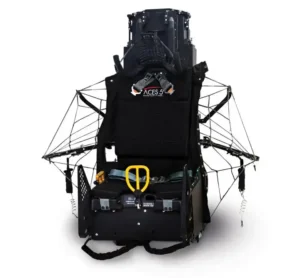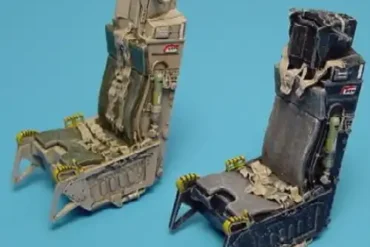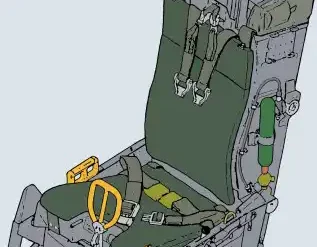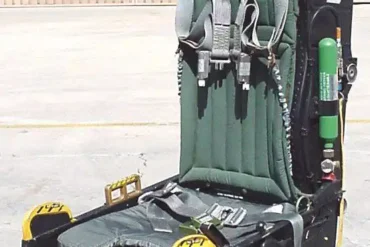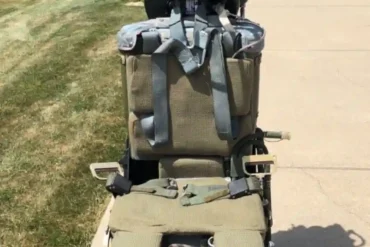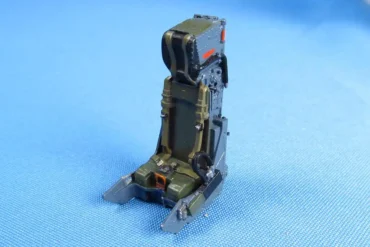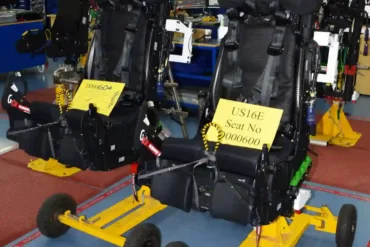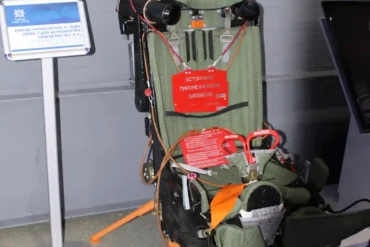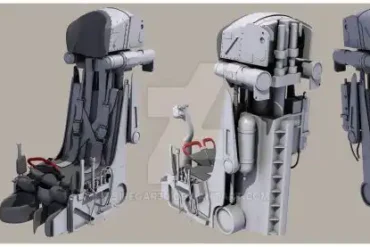The ACES 5 Ejection Seat, developed by Collins Aerospace, is the latest advancement in aerospace ejection seat technology. Building on the proven design of its predecessor, the ACES II, the ACES 5 integrates a wide array of cutting-edge safety features, technological improvements, and cost-saving innovations. This article delves deeply into the unique design, safety features, operational mechanics, and performance benefits of the ACES 5, shedding light on why it is a crucial addition to the safety systems of modern military aircraft.
What is the ACES 5 Ejection Seat?
The ACES 5 Ejection Seat is a next-generation ejection system designed to ensure the highest level of safety for aircrew members in emergency situations. It was developed by Collins Aerospace, building on decades of experience with previous models, including the ACES II, which has saved over 690 lives since its introduction in 1978.
Unlike its predecessors, the ACES 5 incorporates new safety features and advanced technological solutions aimed at reducing the risk of injury during an ejection, regardless of the conditions. This includes improvements to the rocket motor system, stability features, parachute system, and modular design, which ultimately contribute to better performance, reliability, and cost efficiency.
The ACES 5’s Legacy and Evolution
The ACES series began with the ACES II in 1978, which quickly became the standard for ejection seats due to its proven performance and safety features. The ACES 3 and ACES 4 were test models that laid the groundwork for the ACES 5’s development. By integrating extensive feedback and advancing technology, Collins Aerospace created the ACES 5, setting a new standard for military ejection seats.
With aircraft models like the F-15, F-16, B-1, B-2, and T-7 being the primary platforms for the ACES 5, it is clear that Collins Aerospace has prioritized both safety and compatibility. The ACES 5 can support aircrews ranging from 103 to 245 pounds, and is suitable for use in both high-speed and low-speed ejection scenarios.
Key Features of the ACES 5 Ejection Seat
The ACES 5 ejection seat incorporates several advanced features that set it apart from earlier models. Here are some of the most notable:
1. Passive Head and Neck Protection
One of the most critical safety features of the ACES 5 is its passive head and neck protection system, which has been qualified to meet the latest MIL-HDBK-516C injury requirements. This is especially important as modern aircrews now wear heavier helmets, night vision goggles, and other equipment that increases the risk of head and neck injury during ejection.
The ACES 5 ensures that the head and neck are adequately restrained during ejection, even in extreme conditions. The passive headrest automatically adjusts to the height of the aircrew member, providing optimal support during the ejection sequence.
2. Advanced Stability Package (STAPAC)
The ACES 5 features an advanced stability package (STAPAC), which provides active pitch stabilization to counteract aerodynamic effects and compensate for variations in aircrew weight. This is vital in maintaining stability during ejection and reducing the risk of injury caused by erratic movements. The STAPAC system ensures that the pilot is not subjected to excessive forces that could lead to spinal injuries or other harmful effects.
3. Rocket Catapult and Soft Ride Technology
The ACES 5 is equipped with a CKU-5C rocket catapult, which provides the softest ride available in an ejection seat. This innovation helps to minimize the forces acting on the pilot during ejection, particularly in high-speed scenarios. The system is designed to limit the spinal injury rate to less than 1%, ensuring that the aircrew member is safely ejected from the aircraft without sustaining serious injuries.
4. Large Survival Kit Volume
A notable feature of the ACES 5 is its large survival kit, which provides 1,500 cubic inches of storage. This extra space allows for a more comprehensive set of survival tools, increasing the chances of the aircrew member’s survival after ejection. The larger kit can accommodate essential items such as food, water, medical supplies, and signaling devices, all crucial for post-ejection survival.
5. Parachute System for Controlled Descent
Once the ejection seat has safely separated from the aircraft, the GR7000 main recovery parachute is deployed. This parachute is designed to significantly reduce the descent rate of the aircrew member to less than 21 feet per second, or 15 knots. The GR7000 also offers improved control and stability during descent, enabling the pilot to steer away from potential hazards such as trees, bodies of water, and enemy forces.
6. Enhanced Electronic Sequencing and Automatic Mode Selection
The ACES 5 ejection seat features an advanced electronic sequencing system, which can adjust the ejection profile based on critical factors such as altitude, airspeed, and aircrew weight. Sensors detect these parameters and automatically adjust the seat’s ejection mode to ensure optimal safety. The four primary ejection modes are low and slow, low and fast, high and slow, and high and fast, each tailored to specific ejection conditions.
How the ACES 5 Ejection Seat Works
The ACES 5 ejection seat operates in a highly sophisticated and coordinated manner to ensure a smooth and safe ejection for the pilot. The process begins when the pilot pulls the ejection handles, located either between the legs or along the sides of the seat. This action triggers a series of events that occur within milliseconds.
1. Arming and Initial Ejection
Before the ACES 5 can be activated, the seat must first be armed on the ground to prevent premature ejections. Once armed, pulling the ejection handle activates the first of three rocket motors. The initial rocket fires the seat out of the aircraft, providing the necessary thrust to separate the pilot from the aircraft structure.
2. Stabilization and Separation
The second rocket motor sustains the ejection, ensuring a clean separation from the aircraft. The STAPAC stability package comes into play at this stage, stabilizing the ejection and minimizing the risk of the pilot being tumbled or twisted in the air. This system helps to ensure that the pilot’s body remains in the correct orientation for safe descent.
3. Parachute Deployment and Controlled Descent
After separation, the parachute system is deployed, and the GR7000 main recovery parachute takes over, reducing the descent rate and allowing the pilot to steer away from hazards. The parachute system provides a controlled and stable descent, ensuring the pilot’s safety upon landing.
4. Survival Equipment for Post-Ejection
The ACES 5 seat also provides the pilot with a variety of survival tools stored in the seat pan. This includes signaling devices, first aid kits, and water supplies, all of which are critical for the pilot’s survival after ejection. This unique feature increases the likelihood of a successful post-ejection recovery.
The Grasshopper Club: Honoring Ejection Survivors
Collins Aerospace has established a unique program called the Grasshopper Club to honor the pilots who have ejected from ACES seats. Membership in this club is reserved for individuals who have experienced the ejection process firsthand. The Grasshopper Club meets biannually to share stories and experiences, providing invaluable insights into the real-world impact of the ACES 5 ejection seat and helping Collins Aerospace improve its products.
The club serves as a reminder of the critical role ejection seat technology plays in saving lives. To date, the ACES 5 seat has been credited with saving over 714 lives, and its continued refinement ensures that future ejections will be even safer.
Conclusion: A Leap Forward in Aircrew Safety
The ACES 5 Ejection Seat represents a monumental leap forward in aircrew safety and performance. Its innovative design, advanced features, and rigorous testing make it the ejection seat of choice for the U.S. Air Force and allied air forces. With its modular structure, enhanced parachute system, stability package, and advanced electronic sequencing, the ACES 5 ensures that aircrews can eject safely and return home after facing one of the most dangerous situations in aviation.
Collins Aerospace has once again proven its leadership in the aerospace industry, providing air forces around the world with a cutting-edge safety solution that dramatically improves the chances of survival during an emergency ejection. As the ACES 5 continues to be integrated into military aircraft like the F-15, F-16, B-1, B-2, and T-7, it is clear that the future of ejection seat technology is brighter than ever.
